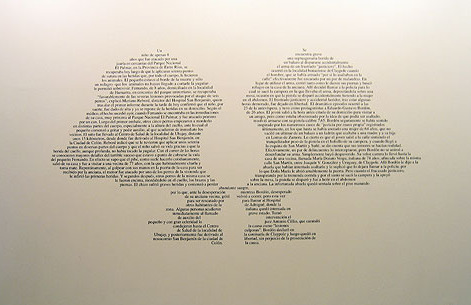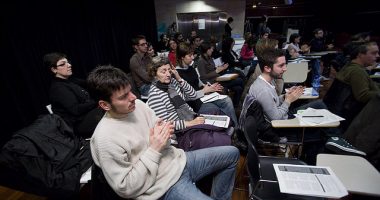
Jorge Macchi. Doppelgänger. 2005.
It is undeniable –McLuhan dixit- that new media is reformatting our cognition and subsequently, our relationships. Social networking services are a literal example of this. Probably, in our era building other connections moves via software design and by taking these new environments into consideration, a critical interaction is opening up new literary horizons.
In “Complex networks”, Ricard Solé presents recent scientific discoveries in network science. The study of the architecture of the network is centred on the analysis of interaction between elements rather than on the isolated parts. The research shows an underlying universal regularity in seemingly different areas: economics, biology, language, electric systems and social interactions, producing a revolution in the cartography of complexity. In Solé’s words, when we combine elements many phenomena that didn’t occur on a lower scale, emerge.
Architectures of interaction are characterized by the structure of the “small-world network”, that is, a certain degree of randomization between the connections within a system provide the creation of short cuts between its components. One of the experiments that confirms the hypothesis is the theory of ‘Six degrees of separation’, proving how close we are to any other person in the world. The simplicity of the spreading of information in “small-worlds” also produces a collapse when one of the connection nodes is damaged. This damage reacts like a cancer on a cellular level in the body and is thus mirrored in informatic viruses. Unlike highly hierarchical systems, they are interdependent systems with a less specialized distribution of functions, which constitutes on one side its strength and, on the other side, its fragility. See ‘global warming’ or ‘global economic’ crisis.
Relating this theoretical frame to social networking services:
“What’s up?” is a typical question when we make a phone call to a person in our inner circle. Although the answer is usually “having a coffee” or just “cooking”, sharing this information makes us feel connected. Both Facebook and Twitter have been designed to fulfil this communication function that we can call phatic. If FB is widely known, the second, perhaps, requires a short presentation. Twitter is a social networking service that enables its users to send and read messages limited to 140 characters. The tweet updates the current state of the user in a synthetic way. One of the differences between the two services lies in the fact that in FB it is necessary to give “friendship” consent to add the other person to our group of contacts, while the default options in Twitter allow it to “follow” and be “followed” by anyone. The basic spreading outline of this kind of program is many-to-many.
The features of Twitter enable users to reach high rates of followers, therefore, increase the spreading capacity. The “whales”- users who have more than 2000 followers- are, in Network Systems, hubs, or nodes that have a high rate of connectivity. These nodes move most of the information, and, at the same time, are those which usually propagate more viruses; a characteristic of both social networks and cellular systems. A transmission failure in one of the hubs or in a cell would produce a ‘cancer’ or a network collapse.
According to Mike Murphy, Vice President of Sales at FB, only a 10% of Twitter’s contents are produced by users. Although it depends on who we follow, that is, on the community of interests we are part of, most of the messages are usually links or retweets: resent messages. Whatever the intention of the user might be the immense spread capacity of tweets has made them a perfect breeding ground for viral marketing, making it difficult to distinguish between publishing and publicity.
The potential to amplify the concept of literature through these interfaces is being explored. The many-to-many of Twitter favours collective creation. The writer Cristina Rivera Garza has been one of the first to use the device as a literary creation tool. The “Tuitnovela” –Spanish for Tweet-novel-, is based on the collective writing through tweets in the same “Timeline” – the interface section kept for a particular conversation between users. For Cristina Rivera Garza what matters in these kinds of worksis the “plural production of a structure”, so these works are based in the bajtinian concept of polyphony and juxtaposition.
An Exquisite corpse? Partly. The chance of group writing in real time, the brevity of space -in a similar way to SMS-, inclines towards aphorism and reminds us of the poetic genre of haiku. According to the theorist Josefina Ludmer, post autonomous writings are those who, outside the confines of the literary, are devoted to the production of present. Ludmer tries to place authors whose works, “don’t admit a literary reading; in other words, that we don’t know or don’t care if they are literature. It doesn’t matter if they are fiction or real”. They place themselves locally in everyday life to ‘make present’ and that is precisely its sense”. These authors assert the economical character of what is cultural and vice versa. In the words of Cristina Rivera Garza, these writings confirm that “reality is already in itself a fiction, and fiction is our daily life”.
One example of the creative opportunities of Twitter explored by the author are the #cuentuitos. The hash key before the name point out that it is a hashtag: a tag that groups all the comments under the same subject. The #cuentuitos are tales written through the aforementioned social network service and therefore limited to 140 characters. Cristina Rivera Garza was the curator of the first Twitter life-writing event. As a theoretical manifesto it’s worth visiting “La producción de presente”.
Regardless of the orientation and quality of the works, most of the literary initiatives that incorporate 2.0 dynamics have the common concepts of connection and collectivity. The socialization of the reading experience, the polyphonic creation and the supranationality (or globalization, in its negative meaning) are a common part of their identity. Even though some of these writings have dissociated themselves from the literary intention –and maybe that could be an advantage-, we can consider whether in front of the profusion and specialization of on-line social networking and publishing services, the “production of virtual present” is equivalent to communication (artistic or not). In view of the interest of these initiatives, it’s worth to endeavoring that the global tweet doesn’t silence singular voices. To find strategies to inhabit creative ecosystems in a small-world involve, according to Solé, collaboration.






Leave a comment